#like. taxonomy classes
Note
hey mac ghostzone ur very cool and are a big reason why i actually went into ecology instead of settling for a 'safer' major <3 🦕 stay swagg
WAAAAH THATS SO COOL????????? thats SO cool im happy u found smth ur passionate about !!!!!!! i hope ur enjoying it so far !!!!
#YOU ALSO STAY SWAG !!!!!!!!#omg this makes me so 🥺#SORRY I AM. GETTING OVER A COLD mt brain is still goopy so i dont habe a LOT of words rn but !!!!!!!!!!!!!!#ecology is so cool tho i had 2 take likeee 3 semesters of an ecology class as part of my major#and its soooo interesting......#IDK IF UR SCHOOL OFFERS UHHH !!!#like. taxonomy classes#but if they do i VERY much recommend those. i think taxonomy is so cool and i feel like its also pretty closely related to ecology#cause its like. evolutionary relationships n stuff????#idk i had a class called vertebrate biology and we LITERALLYYYY just went through the entire phylogenetic tree#like . started w hagfish and ended with mammals. it was SO cool best class i ever took#ANYWAY I AM JUST. TAG RAMBLING NOW!!! its ur first semester right??? i hoppe college is treating u well <3#asks#din0draws
2 notes
·
View notes
Text
Class Round 1: Nymphaeales vs Ceratophyllales

Water Lilies vs Aquarium Plants
Nymphaeales: A basal clade of Magnoliophyta that contains the water lily family, and other aquatic plants with prominent flowers. Water lilies with larger flowers and more complex parts are pollinated by beetles -- they were initially believed to be plants that evolved earlier, but while Nymphaeales as a whole did diverge early, the ones with more flower parts did not diverge earlier than the ones with fewer flower parts. Water lilies were used as an indicator of water cleanliness in the Maya civilization, were a symbol of the Maya elite, and were likely used in a religious context to induce altered states of consciousness.
Ceratophyllales: Core Magnoliophytes that are very closely related to the eudicots. These aquatic plants are found all over the world, and are known as coontails or hornworts (though they are not related to the non-vascular hornworts from the phylum battle.) Ceratophyllum demersum is sold as an aquarium plant, and is considered invasive in Tasmania and New Zealand, where it has been known to interfere with hydroelectric power plants.
#before I started this tournament I would have assumed#that ceratophyllales wouldn't get many votes#but given the apparent deep and widespread love#of moss-like plants#who knows really?#nymphaeales#ceratophyllales#plant taxonomy showdown#battle of the plants#class round 1#class#plant bracket#tumblr bracket#bracket tournament#poll bracket
38 notes
·
View notes
Text
sewing class is so silly. why am i stressing about a test on stitching. needle goes up needle goes down!
#sewing is serious and exhausting but also what am i doin#then again my teacher says its gonna be 1.5 hours long which is kind if insane no??#i dont THINK shes gonna test us on like seam classification and taxonomy but like it is very much in our books so 😬#i posted pics a couple weeks ago of those pages yall rememver how insane those diagrams are?#ngl the idea of a written test for this class is crazy like i can use a machine more or less perfectly what more do you want from me#n its like 15% of our grade too fucking hell#this isnt even vent im not that scared because this class doesnt matter like at all its just an extra curricular but like damn
4 notes
·
View notes
Text
Me, running around as Cyno: Alright, Razor, time to talk canine-to-canine! Wait, are Jackals canines?
Friend: I'm more surprised you don't know this off the top of your head.
Me, looking it up: Yeah, same. Also, yeah, they are.
3 notes
·
View notes
Text
It's a bit funny how people characterise people into classifying music into genres and whatever as a Tiresome Task They Must Force Themeselves To Do To Maintain Gatekeeping because like taxonomy is just SO fun fr. me when there are debates about what exactly constitutes darkwave
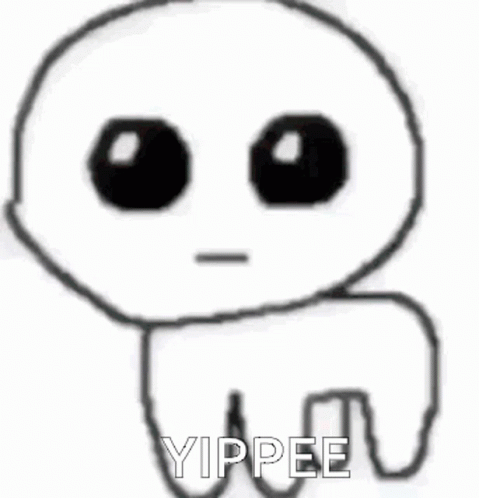
#spent like 3 hours in classes and lectures today having discussions about different species concepts and which ones are better for what#situations today and like idk this is awesome fr.#taxonomy arguments are like my second favourite part of biology after field trips to see creatures fr
0 notes
Text
Wet Beast Wednesday: walrus
There are a lot of iconic arctic animals, such as the polar bear and narwhal, but my personal favorite is the walrus. Known for their large tusks, prominent whiskers, and habit for busting myths creepy eyes, walruses are unique amongst the pinnipeds. Most people know of the two main groups of pinnipeds: Phocidae, the earless or true seals and Otariidae, the fur seals and sea lions. Walruses however are in a class of their own, being the only surviving species of their own family: Odobenidae. A weird fact that I learned researching for this is that taxonoimists used to think Odobenids evolved from bears before later reclassifying them alongside the other pinnipeds. Old-timey taxonomy was wild and came up with some absolutely unhinged ideas. Like they used to think that microbats and megabats weren't related, instead classifying megabats as primates.

(image; a walrus sitting on an ice flow. It is a large, brown mammals with short limbs that end in flippers. Its head has a wide, blunt snout and two long tusks emerging from the upper jaw)
There is one species of walrus, Odobenus rosmarus, divided into two subspecies based on location: the Atlantic walrus (O. r. rosmarus) and Pacific walrus (O. r. divergens). The two subspecies are still very similar and genetic testing indicates they diverged between 750,000 and 500,000 years ago. There used to be a third listed subspecies from the Laptev sea, O. r. laptevi, but they have since been reclassified as a population of the Pacific walrus. Walruses are very large, being the third largest pinnipeds after the two elephant seal species. The Pacific subspecies is larger than their Atlantic brethren with most males reaching an average weight between 800 and 1,700 kg (1,800 to 3,700 lbs). A few males have been known to grow considerably larger than average. Male Atlantic walruses average about 900 kg (2,200 lbs). In both subspecies, females are about 2/3 the size of males and have shorter tusks. a large portion of their weight comes from the thick layer of blubber under their skin that helps them stay warm. Both subspecies have an average length between 2.2 and 3.6 meters (7.4 to 11.8 ft). Walruses have hind flippers that can turn forward to act like feet, letting them crawl on all fours like sea lions. Like true seals, they have no external ears. The skin is very thick and mostly bald. They are born with brown skin that becomes lighter as they age. While swimming, the blood vessels in the skin construct to reduce blood flow and limit heat loss, which makes them considerably lighter, almost white. Males have skin nodules called bossed around the neck and shoulders. Their creepy eyes are the result of eye sockets with no roof and powerful extraocular muscles that let the eyes protrude out of the skull and look both forward and sideways. The famous mustaches are composed of 400-700 thick whiskers. The whiskers are attached to muscles and have both nerve ending and blood supply. They are incredibly sensitive sense organs and a walrus can identify objects as small as 2mm with its whiskers. Their lips are muscular and flexible and aid in creating a large variety of noises.

(image: a close-up of a walrus's face, showing its prominent whiskers and small eyes. Its mouth is open, revealing its tongue)
youtube
How come the walrus can whistle but I can't? (video: a walrus in a zoo being instructed by its handler to make multiple vocalizations)
Of course the most famous features of walruses are their tusks. These two large canines can reach a meter in length and are larger in males than females. The tusks have a number of uses in both sexes, though males use them more. In both sexes, they are used to help dig breathing holes in sea ice, hang onto ice and help the walrus climb out of the water. Males also use their tusks in displays of dominance, especially during mating season. Larger tusks are a sign of dominance and typically the walrus with the largest tusks will win standoffs. If a standoff escalates from posturing to a fight, they will use their tusks as weapons. They tend to strike around the neck and shoulders and the skin nodules in those areas help protect males from each other's tusks. It was formerly believed that walruses would use their tusks to dig for prey on the sea floor, but this is no longer believed to be the case.

(image: a walrus skull showing the tusks)

(image: a walrus using its tusks to hang onto the ice and keep its nostrils above the water)
Walruses spend a lot of their time searching for the food they need to support a body that big. They prefer forging along the continental shelf and spend much more time in shallow water than other pinnipeds. While walruses have been tracked diving 500 meters deep, the majority of dives are much more shallow. The vast majority of a walrus's diet consists of seafloor-dwelling invertebrates including tubeworms, soft corals, tunicates, crabs and shrimp, sea cucumbers, and mollusks. While that's a wide palette, their absolute favorite food is clams. To hunt, walruses drag their noses and the forward surface of their tusks through the sediment and use their whiskers to search for food. This stirs up the sediment and releases nutrients back into the water column, a process balled bioturbation. Many foods can be swallowed whole or chewed, but they have a special feeding style for clams and other bivalves. Walruses will hold the bivalve in their mouths and use their flexible lips to form a water-tight seal around it. It then withdraws its tongue into its mouth to create enough suction to suck the bivalve meat right out of the shell. So important is this strategy to feeding that the shape of their mouths is specially adapted to it. Walruses are also known to feed on seals, though how much of that is due to hunting or scavenging is unknown. Additionally, they will scavenge whales, may hunt walrus trapped under sea ice, and have been seen catching and eating birds.
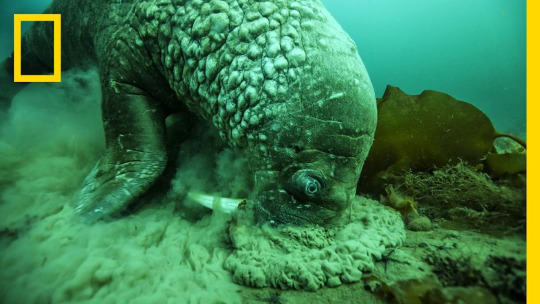
(image: a walrus foraging for food underwater. It has its snout pressed into the sea floor and is kicking up a large amount of sediment. Still from a National Geographic video)
Walruses are social and migratory, traveling south for the winter and north for the summer in aggregations that can be tens of thousands strong. They will haul out onto land or sea ice in huge numbers, blanketing the landscape in blubber and tusks. While these aggregations are preferred, they are not considered a true social species as they do not aid each other when together. Walruses on land or ice are skittish and will spook easily. Being startled can lead to stampedes while the walruses flee back to sea. Sometimes, walruses will be trampled to death during these stampedes. During mating season, the normally cordial walruses become much less friendly to their neighbors. Breeding seasons lasts from January to March. During this time, males will gather in the water around females in heat and compete for the change to get to that nice walrussy (I will not apologize). This is usually done via bellowing and posturing with the tusks, but may escalate to fights. While males become sexually mature around age 7, they often do not become large and strong enough to secure mates until around age 15. Females become sexually mature between 4 and 6 years old. Curiously, females enter heat twice per year, but males are only fertile once per year. Gestation takes up to 16 months and calves are born able to swim and weighing up to 75 kg (165 lbs). Females with calves move away from the large aggregations, possibly to keep their calves from being crushed in stampedes and possibly to make it harder for predators to detect their scent. Nursing lasts for over a year, longer than in many pinnipeds. Walrus milk is fattier than that of land mammals, but less fatty than that of true seals, forcing walrus mother to nurse longer. Even after being weaned, walruses may spend up to 5 years with their mothers. Females only mate at most every two years, which gives the walrus the lowest reproduction rate of all pinnipeds. Walruses can live up to 30 years in the wild and 40 years in captivity. Male walruses have the largest penis bone of any non-cetacean both in absolute size and proportionately.
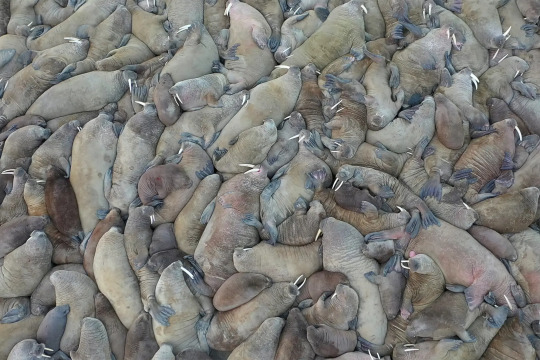
(image an aerial shot of a walrus herd on land. There are many walruses and they are so tightly packed together that no ground is visible)

"Don't talk to me or my son ever again" (image: a mother walrus with its calf. The calf is a smaller version of the mother with no tusks. The calf is sittting by its mother's side. Both are looking at the camers)
Walruses have been hunted by humans living in the arctic circle for millennia. Hunting peaked in 18th and 19th centuries when there was a high commercial demand for meat, blubber, skin, and ivory. This almost led to the extirpation of Atlantic walruses. Since then, hunting has been outlawed except by indigenous peoples, allowing the populations to recover. Now, the major threat to walruses is climate change leading to loss of sea ice needed for hauling out and breeding. The IUCN lists both subspecies as Vulnerable. They were an important source of food and other materials to the peoples of the arctic circle and appear frequently in the mythology of said peoples.

(image: a walrus tusk carved with the images of multiple fish, seals, and polar bears)
#wet beast wednesday#walrus#pinniped#marine biology#zoology#ecology#marine mammals#animal facts#biology#Youtube
503 notes
·
View notes
Text
also final word on this probably- I *like* Joyce Messier a great deal as a character. I think she's cool and interesting. I find it fascinating that she tends to approach things very bluntly. the words she uses and the manner in which she analyzes things, this is sort of an instance of a character who knows exactly *what she is* and articulates it in a manner congruent with the writers of the game. she is, as she says wryly but honestly, "a bourgeois woman". i cant think of too many rich people who would without prompting and prodding, self identify with marxist social taxonomies in this way, even with a thin veil of ironic self deprecation.
She's educated. she knows the words and the motivating logics of class analysis. and shes *cool*. harry picks that up. honesty is cool. bluntness is cool. cynicism is cool. she is quite open about her place in the world and how she conceives of it. unlike a lot of other powerful figures in the game, i dont think shes completely swallowed by self justifying rhetoric the way, say, sunday friend is. or she is up to a point. she knows about countercultural movements and she has affinities for them and is also aware that they inevitably are consumed by capital. (this, by the way, is kind of complex in that like. ok its a depressing reality but also i think if the de team was fully bought into that line of thinking, they would not make this game. it is telling that joyce of all people would critique cindy on the basis of capital subsuming revolutionary art. I dont think joyce is wrong per se, but i think she is drawn to that line of thinking because it is *very comforting for someone of her class position to dismiss the value and power of revolutionary art and critique of capital* just a thought)
She's disgusting in that her power is not rightfully hers. her position is not rightfully hers. she is actively repressing and oppressing others in service of disgusting, semi-fascistic, hypercapitalist forces. shes enjoying the comforts and benefits that such a role allows her. shes disgusting shes frustrating shes profoundly arrogant (as her clash with evrart claire proves definitively). Her self satisfied idiocy is what allows her to play with fire and foolishly assume she cannot be burned. She's smart but her comfortable position puts the blinders on her and so she's also pretty fucking stupid.
and shes also deeply deeply sad. I empathize. I pity her. She's so fucking sad. I don't think she is drawn to self medication and self destruction through constant pale exposure or all that rueful nostalgic rumination for no reason. She knows what she is to the world and she knows what she's doing and she's too cowardly and comfortable and self interested to change, but she's too self-aware to ignore it completely. I think she probably dislikes herself to some degree and i think its destroying her. Like most of the cast of the game, she's complex and deeply human. She's hateful, but I also think she is too well realized to hate, at least not for me.
#i envy her obviously but i also pity her a fucking lot#i think she lives an adventurous appealing life that is largely facilitated by her moral cowardice#and is honestly characterized as profoundly empty and disheartening for her#shes a vibrant person and that vibrancy is being turned to ugly ends and its killing the spark#oppressive structures are bad for the oppressors too#joyce is a middleman to power but she is still in a place of power over the ppl she interacts with#that grants her a lot of excellent perks but its making her miserable and it renders her deeply pathetic imo#disco elysium#joyce messier
356 notes
·
View notes
Text
Taxonomy of Ace Attorney Weirdgirls
Single-Type Weirdgirls: Maya Fey, Pearl Fey, Trucy Wright, Princess Rayfa, Kay Faraday
Dual-Type Weirdgirls/Attorneys: Athena Cykes, Sebastian Debeste
Dual-Type Weirdgirls/Mad Scientist: Ema Skye, Iris Wilson
Weirdgirls Who Did a Class-Change to Attorney: Phoenix Wright, Raymond Shields
Weirdgirls With One Level in Attorney: Susato Mikotoba
Attorneys With One Level in Weirdgirl: Apollo Justice, Franziska Von Karma, Simon Blackquill
Not Weirdgirls but Exhibit Weirdgirl-like Traits Due to Convergent Evolution: Luke Triton, Dick Gumshoe
#ace attorney#aa#pwaa#phoenix wright#pheonix wright#phoenix wright: ace attorney#phoenix wright ace attorney#gyakuten saiban#Maya Fey#Pearl Fey#Trucy Wright#Princess Rayfa#Kay Faraday#Athena Cykes#Sebastian Debeste#rayfa padma khura'in#Ema Skye#Iris Wilson#Phoenix Wright#raymond shields#Susato Mikotoba#the great ace attorney#Apollo Justice#Franziska Von Karma#Simon Blackquill#Luke Triton#Dick Gumshoe#maya ace attorney#aa maya#mayoi ayasato
308 notes
·
View notes
Note
Birds are class Aves.
Sure, under Linnaean taxonomy. But, well,
A) Linnaeus was a eugenecist so his scientific opinions are suspect and his morality is awful
B) he didn't know about evolution
C) he didn't know about prehistoric life
so his classification system? Sucks ass. It doesn't work anymore. It no longer reflects the diversity of life.
Instead, scientists - almost across the board, now - use Clades, or evolutionary relationships. No rankings, no hierarchies, just clades. It allows us to properly place prehistoric life, it removes our reliance on traits (which are almost always arbitrary) in classifying organisms, and allows us to communicate the history of life just by talking about their relationships.
So, for your own edification, here's the full classification of birds as we currently know it, from biggest to smallest:
Biota/Earth-Based Life
Archaeans
Proteoarchaeota
Asgardians (Eukaryomorphans)
Eukaryota (note: Proteobacteria were added to an asgardian Eukaryote to form mitochondria)
Amorphea
Obazoa
Opisthokonts
Holozoa
Filozoa
Choanozoa
Metazoa (Animals)
ParaHoxozoa (Hox genes show up)
Planulozoa
Bilateria (all bilateran animals)
Nephrozoa
Deuterostomia (Deuterostomes)
Chordata (Chordates)
Olfactores
Vertebrata (Vertebrates)
Gnathostomata (Jawed Vertebrates)
Eugnathostomata
Osteichthyes (Bony Vertebrates)
Sarcopterygii (Lobe-Finned Fish)
Rhipidistia
Tetrapodomorpha
Eotetrapodiformes
Elpistostegalia
Stegocephalia
Tetrapoda (Tetrapods)
Reptiliomorpha
Amniota (animals that lay amniotic eggs, or evolved from ones that did)
Sauropsida/Reptilia (reptiles sensu lato)
Eureptilia
Diapsida
Neodiapsida
Sauria (reptiles sensu stricto)
Archelosauria
Archosauromorpha
Crocopoda
Archosauriformes
Eucrocopoda
Crurotarsi
Archosauria
Avemetatarsalia (Bird-line Archosaurs, birds sensu lato)
Ornithodira (Appearance of feathers, warm bloodedness)
Dinosauromorpha
Dinosauriformes
Dracohors
Dinosauria (fully upright posture; All Dinosaurs)
Saurischia (bird like bones & lungs)
Eusaurischia
Theropoda (permanently bipedal group)
Neotheropoda
Averostra
Tetanurae
Orionides
Avetheropoda
Coelurosauria
Tyrannoraptora
Maniraptoromorpha
Neocoelurosauria
Maniraptoriformes (feathered wings on arms)
Maniraptora
Pennaraptora
Paraves (fully sized winges, probable flighted ancestor)
Avialae
Avebrevicauda
Pygostylia (bird tails)
Ornithothoraces
Euornithes (wing configuration like modern birds)
Ornithuromorpha
Ornithurae
Neornithes (modern birds, with fully modern bird beaks)
idk if this was a gotcha, trying to be helpful, or genuine confusion, but here you go.
all of this, ftr, is on wikipedia, and you could have looked it up yourself.
671 notes
·
View notes
Text
My mom bought me this book for Christmas
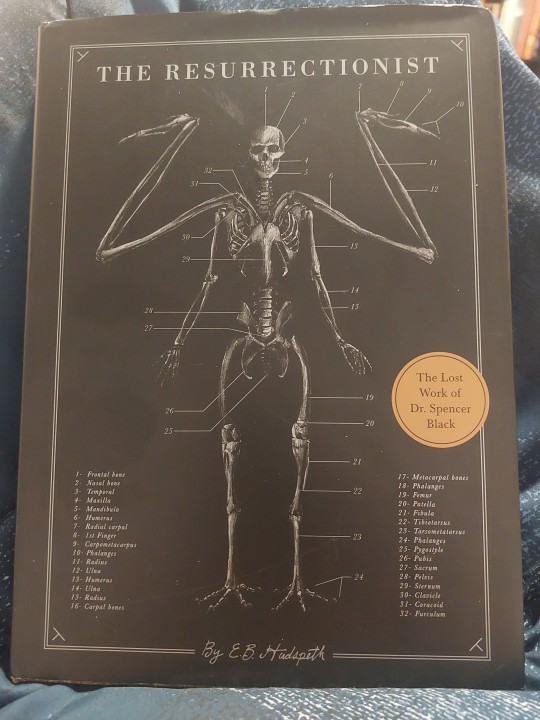
The Resurrectionist by EB Hudspeth, a fantasy field guide full of anatomical illustrations of monsters and cryptids.

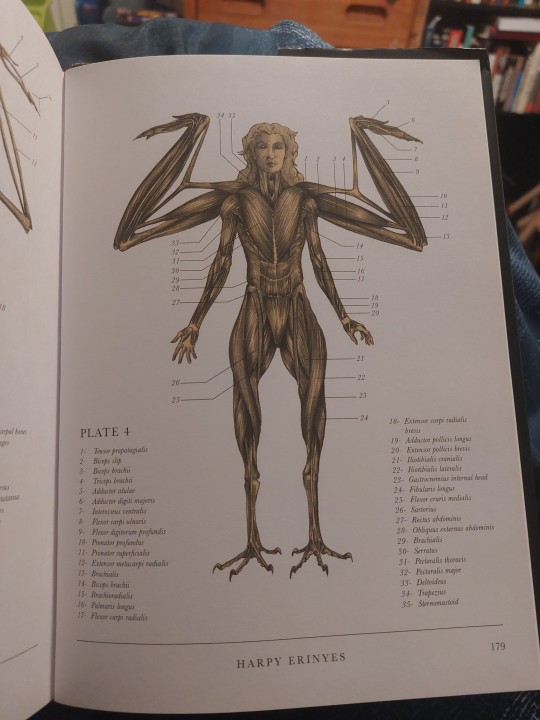
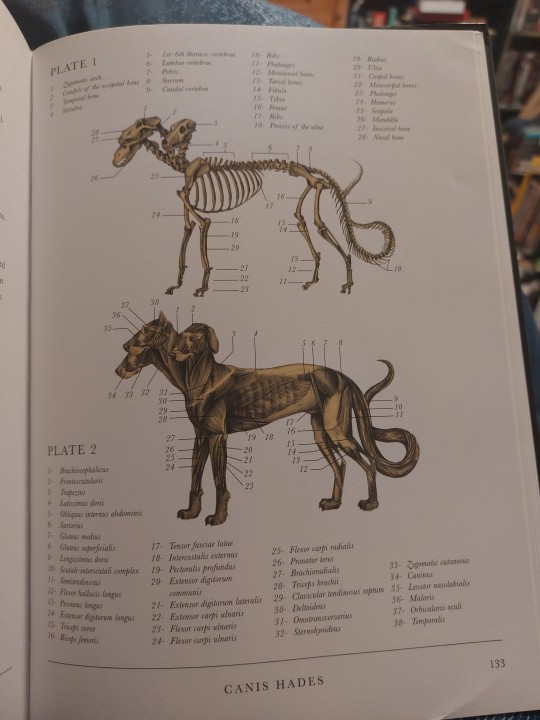

The musculoskeletal systems are fun to look at, but not nearly as in-depth as I would have liked. If you have more than a passing knowledge of taxonomy (or in my case, access to Wikipedia), a lot of the details fall apart under scrutiny
The harpy has four upper limbs connected to one shoulder girdle; it shouldn't have arms, only wings
The sphinx is not classified as a mammal, but is still somehow in the family Felidae with cats (and like the harpy is also drawn with only two girdles despite having six limbs. I will give the author credit for giving the sphinx a keel for the wing muscles to attach to)
It lists the Hindu deity Genesha as a cryptid, which is a no-no.
Cerberus is also explicitly not a mammal, but somehow still a canine (literally in the species Canis with wolves, dogs, and coyotes)
Both mermaids and dragons are listed as members of the order Caudata; the only extant members of Caudata are salamanders, which kinda makes sense for dragons, but not so much for mermaids (also, the author keeps playing it fast and loose with cladistics; both mermaids and dragons are in the same order despite being in different classes, and while dragons are explicitly said to be amphibians, mermaids are given the fictional class mammicthyes, which means mammal-fish. At that point, why not just call mermaids amphibians? Why make up a fake latin hybrid name?)
But what bugs me most of all is the classification of the Minotaur as its own order of mammal when in mythology it is explicitly described as a hybrid of two known species (made possible only by the cruel machinations of the divine, but still)
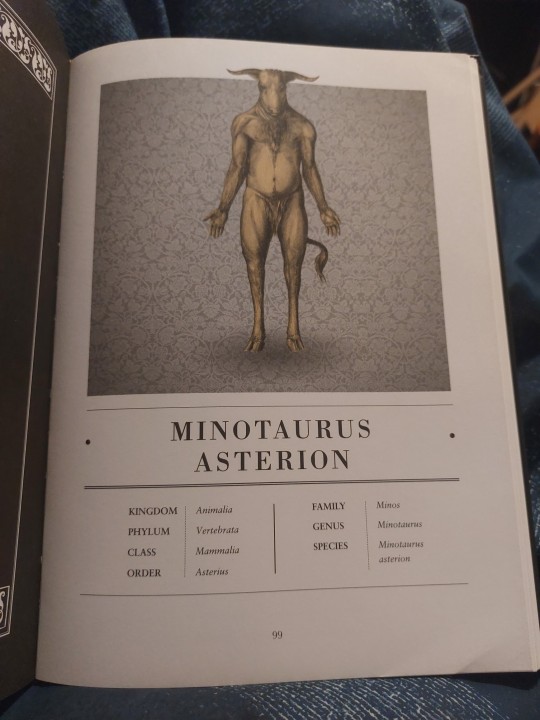
To use actual taxonomical nomenclature, the minotaur's species would be B. taurus × H. sapiens (specifically B. taurus♂ × H. sapiens♀; there are, to my knowledge, no legends of H. sapiens♂ × B. taurus♀). That's how ligers, tigons, mules, zorses, pizzly bears, narlugas, etc., are described.
If I had written this book, I would have leaned more into evolutionary biology. Most land animals have four limbs because they all evolved from boney lobe-finned fish, which split off from the boneless sharks and rays millions of years earlier, so any six-limbed vertebrates would need to be descended from a fictitious category of six-finned fish which would either be an offshoot of boney fish/tetrapods (I guess they'd be hexapods, though that term refers to insect arthropods), OR a precursor to boney and cartilaginous fish that both clades split away from much earlier (it's easier to lose structures than to gain them, so it makes more sense for a six-limbed ancestor to spawn four-limbed descendants than the other way around).
Think about how different elephants are from humans, and humans are from aligators, and aligators are from penguins, and remember that they all evolved from the same ancestor tiktaalik, an amphibious fish that existed some 375 million years ago. Imagine a precursor six-limbed species and how diverse all its descendants would look after 400 million years. Save for the occasional instance of convergent evolution causing two unrelated species to independently evolve similar body plans to fill the same niche, tetrapods and hexapods would look nothing alike. There would be very little recognizable overlap between the two. A six-limbed "pegasus" would not look like a real world horse, and a six-limbed "dragon" would not look reptilian/dinosaur-ish, for much the same reason that giraffes don't look like frogs; they're just too distantly related. Bonless sharks and boney fish and whales/dolphins all have similar looking bodyplans only because their environment requires the same hydrodynamic shape, while terrstrial vertebrates are much more physically diverse.
#biology#anatomy#monsters#cryptids#cryptozoology#book of monsters#evolution#evolutionary biology#evolutionary history#taxonomy#cladistics#science#hard fantasy#hard science fiction#hard science#tetrapod#hexapod
2K notes
·
View notes
Note
"Both nashville fried chicken, and vegetable biryani, can be eaten for dinner, but that doesn't mean they share any particular essence of dinner-ness." This quote sorta took my mind in a taxonomy direction? Like yeah they don't share an essence of dinner-ness but they could both be taxonomically classified as a meal, under a certain schema. Idk it just seems sort of interesting to apply alchemical-type language to the processes of taxonomy, implying an object in a schema inherits the essence of the class(es) it's contained in
yes that was the point. Both copper and the pussy are classified as female under an alchemical neoplatonist worldview.
308 notes
·
View notes
Note
When you describe lichens, you often start with something like "this is a foliose/fruticose/crustose/etc. lichen..." These are, from what I can tell, morphological features (much like saying a plant is a tree or vine or grass, which are independent of taxonomic classification)? How many of these "-oses" are there, and what do they describe? Thanks!
The "-oses" describe the overall growth form of a lichen, and is our main way of classifying them outside of taxonomy. You're right: it's a lot like saying a plant is a shrub or a tree or a forb, with some individuals blurring the line between these neat classes. The three main growth forms of lichens are:
Fruticose: shrub-like. Lichens that are erect or stalked or bushy or hairlike. I think of them as like, 3D. They typically have a cortex that wraps all the way around the body of the lichen.
Foliose: leaf-like. Lichens with a distinct upper and lower surface, easily separable from the substrate. Flat, looks like a leaf. I think of them as 2D.
Crustose: crust-like. Lichens which adhere directly to the substrate. They lack a lower cortex and rhizines. I think of them as 1D. Is that a thing? It is now. You can only see their upper surface.
Three less common growth forms that often get subclassed under the others are:
Leprose: Eroding, dissolving, or powdery. Composed entirely of loose granules with no distinct cortex.
Squamulose: scale-like. Intermediate between foliose and crustose. The thallus is divided into small lobes that can be closely
Placodioid: crustose in the center and lobed around the margin.
There are -ose's and -ous's and -oid's that get more specific (verrucose, ramulose, rimose, pendulous, caespitose, filamentous, etc.) but these are usually describing a more specific subclass inside those other categories. We also use -ous's to describe what they grow "on". Saxicolous lichens grow on rock, folicolous lichens grow on leaves, terricolous lichens grow on soil, etc.
Here's a link to a lichen terminology glossary. It doesn't have *every* lichen word, but it should have most of the ones I use commonly.
142 notes
·
View notes
Text
So I was watching the funny Lego pajama men show with a friend the other day. I get to the season 2 episode "Child's Play", and I couldn't help but notice something interesting.

They gave the goofy looking fictional dinosaur a full scientific name, and two of those words are real scientific words. They didn't need to do that! But they did anyway!
Ninjago has set foot into my domain! And it shall not be spared from my judgment!
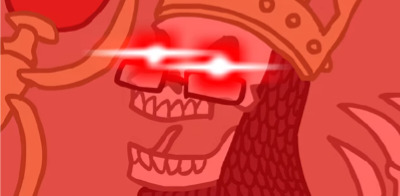
So let's break this sucker down.
Dromaeosaurid Theropod Grundalychus
"Grundalychus" is of course the species name, which there's nothing to really dig into there. People can and will name dinosaurs whatever they want. So in this moment the species name doesn't really matter.
"Theropod" and "Dromaeosarid" are both very real terms though, which gives me something to work with.
I don't really understand why Garmadon would list the family and then the class, but hey he probably just isn't that well read on paleontological taxonomy.
Let's start off with the easy one. "Therapod" is a rather broad class of dinosaur. Covering everything from tyranosaurus and spinosaurus, down to even the little guys like velociraptors and microraptors. They are defined by possessing "sharp, curved teeth, three-toed feet, digits with sharp claws, and long, hollow bones". So lets see how the grundle stacks up.
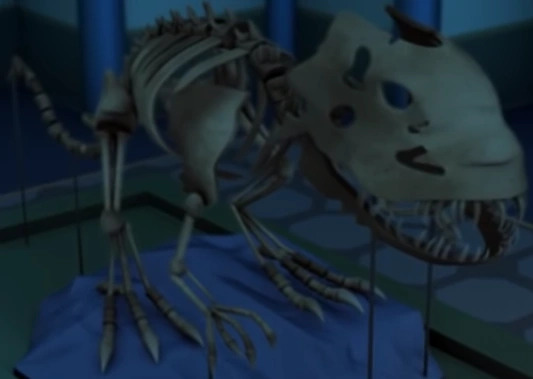
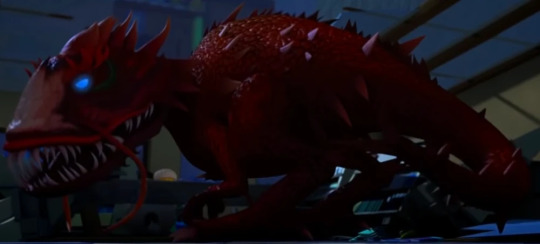
Sharp curved teeth? Check.
Three toed feet? Check.
Digits with sharp claws? Check.
Long hollow bones? Well there's no way to see if they're hollow, but they sure are long.
The grundle also shares the basic horizontal, bipedal body plan of most if not all theropods, so it absolutely checks out. Grundalychus is a certified theropod. Way to go champ.
Now for the next term. The family "Dromaeosarid". Research tells me that dromaeosars can be easily identified by small to medium size, a raised hooked claw on each inner digit of their feet, and an abundance of feathers. For comparison, here are a few examples of other dromaeosaurs.
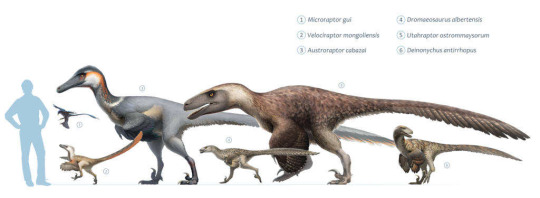
And yeah, our boy grundle doesn't match a single one of the qualifications. No hooked toe claw, he's fricken massive, and unless you want to count his weird head protrusions as feathers, he is absolutely nude. Grundalychus is absolutely not a dromaeosaur.
But not all is lost! After some light digging around, I think I found a group that grundalychus might feel a little more at home in. Behold, mapusaurus. Member of the family carcharodontosauridae.
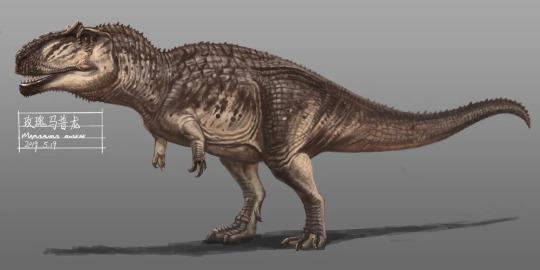
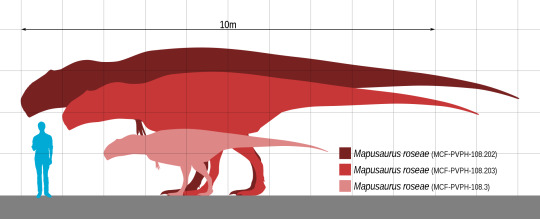
The general head shape and size line up fairly well, and looking at other members of carcharodontosauridae like acrocanthosaurus and giganotosaurus, I feel like grundalychus could slide in pretty easily.
Then again, grundalychus' hands seem to be a lot more developed than most other members of the family, so it might not be a perfect fit. But it's the best one I could find.
#ninjago#lego#lego ninjago#grundle#dromaeosaur#theropod#mapusaurus#giganotosaurus#paleontology#taxonomy#lord garmadon#ninjago garmadon#dinosuar#dinosaurs#Its really not often I get to flex my paleontological expertise like this#this has been so much fun
362 notes
·
View notes
Text
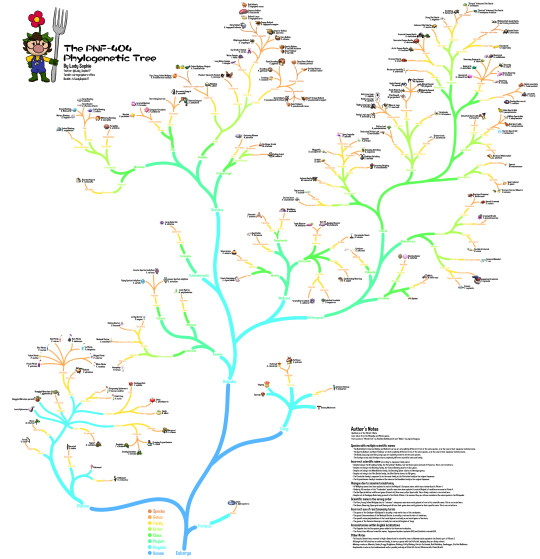
The PNF-404 Phylogenetic Tree
A bit of a different post from the usual, as I have been very hyped for Pikmin 4! Here's my speculative phylogenetic tree for most of the creatures in the Pikmin series. It is a bit more cautious than an actual phylogenetic tree, so there are a lot of soft polytomies (ideally every branch split should only have two children), but I digress.
Edit
It seems that Tumblr's compression did some nasty work on my post, so I'm gonna leave here a link to my phylogenetic tree in case anyone would like to see it in its full glory.
Here are also all the notes on the image in case anyone needs those too:
Author's Notes
Updated as of the Pikmin 4 Demo.
Icons taken from the Pikipedia and Pikmin games.
Fonts used are “Pikmin Font” by TheAdorableOshawott and “Dimbo” by Jayvee Enaguas.
Species with multiple scientific names
The Red Bulborb, Empress Bulblax and Bulborb Larvae are all explicitly different forms of the same species, as is the case in their Japanese technical name.
The Spotty Bulbear and Dwarf Bulbear are both explicitly different forms of the same species, as is the case in their Japanese technical name.
The Baldy Long Legs and Hairy Long Legs are explicitly stated to be the same species.
The Centipare and adult Centipare have completely different scientific name and family.
Incorrect scientific name (according to Japanese family name)
Despite being in the Breadbug family, the Fiery Dwarf Bulblax, has the Oculus genus instead of Pansarus. This is corrected here.
Despite not being in the Blowhog family, the Tusked Blowhog shares its Sus genus.
Despite not being in the Mandiblards family, the Shooting Spiner shares its Himeagea genus.
Despite not being in the Flint Beetle family, the Glint Beetle shares its Pilli genus.
The Floaterbie family is supposed to be the same family as the Flutterbie family in the original Japanese.
The Crysanthemum family is considered the same as the Dandelion family in the original Japanese.
Changes due to assumed consistency
All Wollyhop names have been updated to match the Wolpole's European name, which was standardized in Pikmin 4.
Similarly, All mentions of the “frodendum" specific name have been updated to match Wolpole's frondiferorum name in Pikmin 4.
The Red Spectralid has a different genus (Fenestrati) than every other Spectralid. This is likely a mistake is corrected here.
Despite not all Candypop Buds being present in the Pikmin 4 Demo, it is assumed they are all now considered the same species in the Piklopedia.
Scientific name in the wrong order
The Fiery Young Yellow Wollyhop has its “volcanus" subspecies name incorrectly placed in front of its scientific name. This is corrected here.
The Queen Shearwig, Speargrub and Sheargrub all have their genus incorrectly placed as their specific name. This is corrected here.
Incorrect use of real taxonomy terms
The genus Chilopoda of the Centipare is actually the real world class of the centipedes.
The genus Stauromedusae of the Medusal Slurker is actually a real world order of cnidarians.
The specific name phytohabitans of the Leech Hydroe is actually a real world genus of bacteria.
The genus of the Common Glowcap is actually the real world kingdom of fungi.
Inconsistencies within English localizations
The Coppeler has the Scarpanica genus added in the American localization.
The Armurk has different scientific names: Tegoparastacoidea reptantia (US) and Scalobita rotunda (EU).
Other Notes
The Caustic Dweevil was renamed to Hydro Dweevil and its scientific name to Mandarachnia aquadis in the Switch port of Pikmin 2.
Although the Puffstool has no confirmed family, it shares a genus with the Puffstalk, implying they are likely related.
Missing creatures: Mamuta, Smoky Progg, Blubbug, Puffy Blubbug, Electric Cottonade, Red Blubblimp, Seedbagger, Stuffed Bellbloom.
Unplaceable creatures (extradimensional and/or possibly entirely artificial life forms): Waterwraith, Plasm Wraith.
237 notes
·
View notes
Text
Taxonomy Tournament: Crustacean Finale!

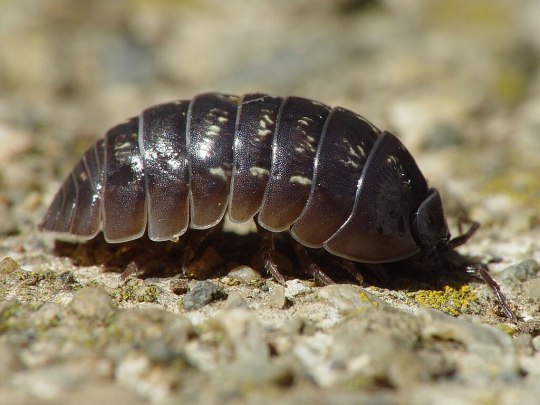
Branchiopoda. This class is made up of fairy shrimp, clam shrimp, water fleas, and the shield shrimp. All members have gills on their apendages, including the mouthparts.
Isopoda. This order is made up of isopods, including terrestrial species like the potato bug and aquatic species like the giant isopod. Some eat dead matter, others are filter feeders, and some are parasites, mostly of fish.
#animals#biology#polls#poll tournament#zoology#fairy shrimp#arthropods#crustaceans#ecdytes#isopods#Branchiopoda#Isopoda#0xev0x31
98 notes
·
View notes
Text
Welcome one and all to the ✨Animal Showdown✨
This blog is singlehandedly inspired by the amazing work happening at @battle-of-the-taxons!! Go give that crazy competition some love!!
Now, those of you who have been closely following the Battle of the Taxons will know that the mighty Kingdom Animalia was narrowly defeated in the final Kingdom round. WELL! Through this blog, the animals have been given the spotlight!
As your dedicated host and taxonomy enthusiast @rosybetta, I would like to invite you to vote for your favorite animal! This bracket will be run very similarly to the Battle of the Taxons: We will start with voting for a Phylum, then Class, Order, Family, Genus, and finally Species. Buckle up, 'cause it's going to be a long journey!
For updates, you can check back on this post, which will be regularly edited as the bracket progresses.
Let the games begin!
Showdown Status: Phylum Round 1 is over! Preparing material for Round 1.5, stay tuned!
Directory (Relevant Posts and Tags):
Complete Phylum bracket list
All Phylum posts/propaganda
Phylum Round 1 polls
Some disclaimers for the Phylum rounds below the Keep Reading!
Animals come in all shapes and lifestyles, and that includes many, many, many parasitic species. I'll do my best to use images that are as family friendly as possible, but if you are sensitive to pictures of parasites, please use discretion. I'll do my best to just use microscope images of the animal itself when possible, and I will never show pictures of blood, gore, or other visible bodily harm.
I will be tagging posts with "cw insects", "cw spiders", and "cw parasites" as relevant. All phyla will also be tagged with their names, for example "platyhelminthes". Please send an ask/message if there is any other content you would like me to tag!
Lastly, please remember that I am just one person! I am a full-time marine sciences PhD student who struggles with mental health issues! This bracket may experience delays, but it's a project I'm really passionate about - please be patient with me!
126 notes
·
View notes